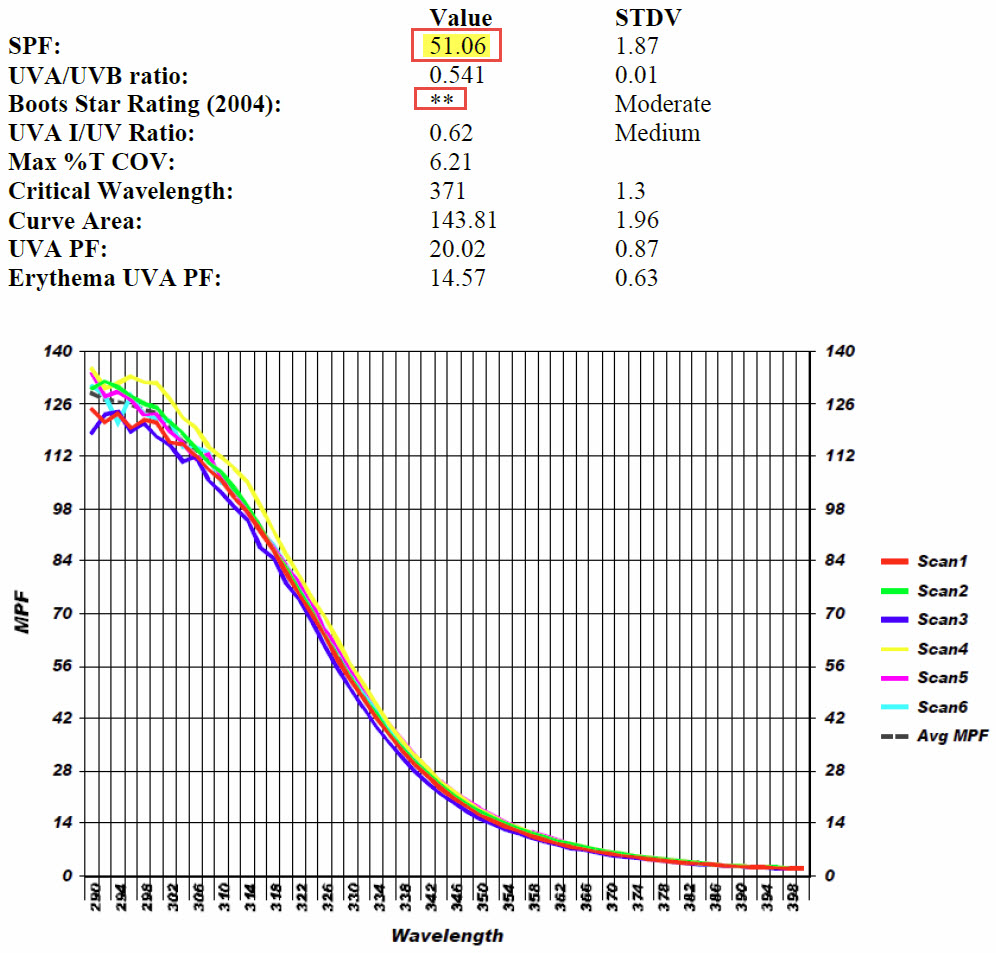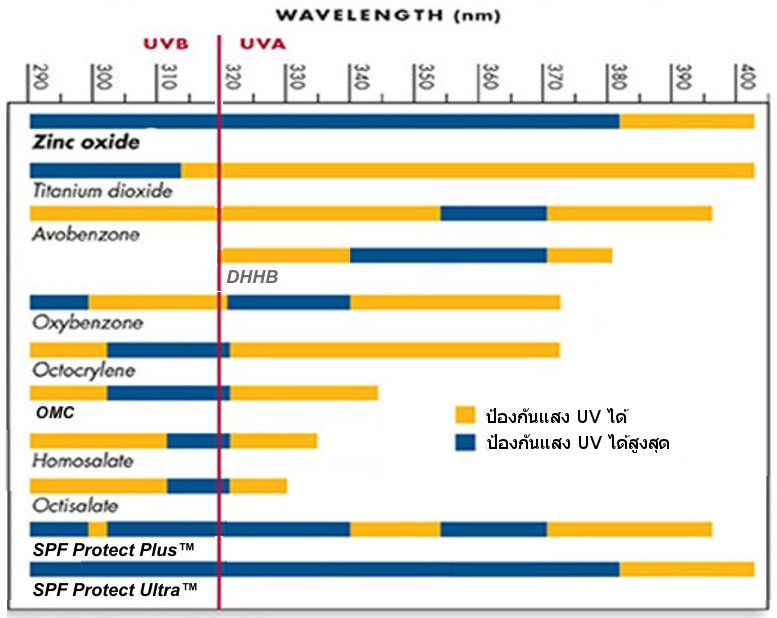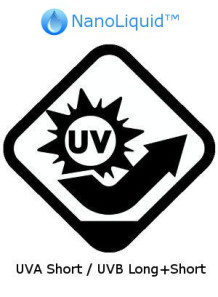Titanium Dioxide 15nm Liquid (Gloss)
- Product Code: 724
titanium dioxide Protects against both UVA/UVB, lightweight, does not contain oil. Doesn't clog pores. High security Contains small particles of 15 nanometers, so it does not make the skin white.
Liquid type: 15nm Liquid, does not make the skin white. But gives a shine (Gloss) suitable for use in Outdoor formulas.
- -
- -
- -
- -
- -
- -
- -
- -
- -
- -
- -
- -
- -
- -
- -
- -
- -
- -
| Test Name | Specification |
|---|---|
| Appearance | White slurry |
| TiO2 content | 34-37% |
| Powder content | 43-45% |
| Mean Primary Particle Size (width, length) | 20nm, 100nm |
| Lead | Less than 10ppm |
| Arsenic | Less than 1ppm |
| Mercury | Less than 1ppm |
| Microbial content | Less than 100cfu/g, no gram negatives |
Titanium Dioxide Titanium Dioxide, 15nm Liquid type, protects against both UVA/UVB, lightweight, does not contain oil. Doesn't clog pores. High security Doesn't make the skin white.
Type 15nm Liquid™ is liquid Titanium Dioxide which has undergone a special process so that Titanium Dioxide powder size 15 Nano Meter can be completely dispersed in every case. Therefore, sunscreen products can be created with ease.
Titanium Dioxide 15nm Liquid is the easiest type of Titanium Dioxide (Sunscreen Grade) to mix. Can be added to cream recipes and stir well Get a sunscreen formula that is highly effective, light on the skin , developed for use in a water-in-oil emulsion system (not recommended for use in an oil-in-water emulsion system). The advantage is that it can coat the skin well. Can be waterproof and has a higher SPF value than formulas in oil-in-water systems. And can also be used with make-up, BB, CC formulas.
Titanium Dioxide 15nm Liquid has active Titanium Dioxide (15nm) equal to 35.5% (34-37%).
Titanium Dioxide 15nm Liquid can be used with formulations containing Avobenzone . Since it is uncoated, Avobenzone does not pose a problem for the stability of Avobenzone.
Example of a sunscreen formula with Titanium Dioxide 15nm Liquid (water-in-oil cream)
1.Water 64%
2. Cyclomethicone 10%
3.Titanium Dioxide 15nm Liquid 25%
4. Mild Preserved Eco 1%
Procedure: Mix 2+3 together with heat at 70 degrees. It will melt together. Then, while blending continuously, gradually add 1 to the formula, then add 4.
SPF results obtained: 51.06, PA++ (Please see SPF measurement requirements and measurement standards below)

Requirements and standards for measuring SPF according to the results of both formulas.
1. Use the SPF-290AS Analyzer.
2. Measured according to US FDA standard scenario.
3. Measure wavelength range 290-400nm
4. Membrane used to apply cream: Transpore
5. Amount of use of sunscreen formula 2 microliters/square meter
6. Number of times to scan / shoot waves: 6 times
7. Steps of wave firing, 2nm/step at a time.
In case you want to adjust the formula to make it more viscous, use any type of Wax, for example Soft Wax or Polyethylene Wax , or use Hectorite Gel (Cyclomethicone Base) or use Hectorite Gel (Isododecane Base), depending on the desired texture.
feature:
-Protects from both short-wave UVA / short- to long-wave UVB.
-Particles of titanium dioxide are 15 nanometers in size, which is the smallest. Allows for the best distribution in any formula.
-It is a Physical Sun Screen which is safer than Chemical Sun Screen.
Should be used in conjunction with Zinc Oxide 35nm Liquid to provide a wider range of sun protection. (broad-spectrum) covers both UVA/UVB wavelengths completely.
The company sells 7 types of Titanium Dioxide:
Group of types for sun protection (Can block UVB light well without being white)
1. Titanium Dioxide 15nm Liquid (liquid, dispersed in water/oil) particle size 15nm, minimally white. Suitable for use in sunscreen formulas. that is desired to prevent whiteness when applied on the skin. Easy to use as it is in liquid form and blends with the formula immediately.
2. Translucent Titanium Dioxide (silicone-coated powder, dispersed in oil/silicone), particle size smaller than 30nm, through a special coating. To make it waterproof Has a translucent appearance But it can also block UV well when used in sunscreen formulas. Doesn't cause any whiteness on the skin. Therefore it can be used at a high rate.
group for concealment or whiteness in make-up products (sorted in order of coverage and whiteness)
1. Titanium Dioxide Super-Coverage Pigment (powder, uncoated, dispersed in water), large particles. White and maximum coverage
2. Titanium Dioxide 200nm EasyDisperse™ (silicone coated powder, dispersed in oil/silicone) medium white. Suitable for make-up formulas that require both sun protection performance and whiteness coating the skin and emphasizes on sticking to the skin well
3. Titanium Dioxide 200nm SilkTouch™ (silicone coated powder, dispersed in oil/silicone) medium white. Suitable for make-up formulas that require both sun protection performance and whiteness coating the skin and emphasizes soft and smooth skin
4. Titanium Dioxide Eco Disperse™ (aluminum hydroxide coated powder, dispersed in water) Medium white, medium coverage, soft to the touch, economical price.
5. Titanium Dioxide Pigment (powder, not coated, dispersed in water) white, less white, less coverage, giving a natural look. Helps adjust skin color or the color of the formula becomes naturally whiter
Advantages of Physical Sunscreen: Less likely to clog pores than Chemical Sun Screen. and is safer than Chemical Sun Screen Because there are no ingredients that can be absorbed into the skin, Physical Sun Screen simply covers the skin and prevents UVA/UVB from hitting the skin directly.
Disadvantages of Physical Sunscreen: Because it is a powder that conceals the skin, it does not allow UVA/UVB light to fall on the skin easily. Therefore, it often makes the skin shinier or shinier when used. The small particle size (nano particle) helps reduce this shine/shine, but it still competes with Chemical Sun Screen. No, it doesn't cause shine/shine.
Difference Between Titanium Dioxide and Zinc Oxide: Both Ingredients It acts to protect against UV light in different wavelengths. Titanium Dioxide can protect against short-wave UVA and both short- and long-wavelength UVB, while Zinc Oxide can protect against long-wave UVA well. In mixing sunscreen formulas Therefore, both ingredients should be used. Because it can cover UVA/UVB at all wavelengths completely.

The company offers a free SPF measurement service in cases where PMMA Booster is used in the formula to help boost SPF/PA values.
Usage rate: 5-50% (use according to desired efficiency It is recommended to be used together with Zinc Oxide 35nm Liquid , according to FDA law, do not use more than 70%, which is equal to active Titanium Dioxide 25%).
Appearance: White liquid
Mixing: Can be mixed with oil. Or the silicone part in the formula, heat it to 70 degrees and stir until combined immediately. Or add it to ready-made formulas such as gel or cream. Heat to 70 degrees and stir until combined immediately.
*Cannot be used in formulas containing electrolyte because the product is dispersed/emulsified in an emulsifier that cannot tolerate electrolyte*
Storage: Store at room temperature. Avoid sunlight. Shelf life: 2 years.
INCI: Titanium dioxide (and) Cyclomethicone (and) PEG-10 Dimethicone (and) Triethoxycaprylylsilane
Be the first to review this product :-)
Recent dicussion threads:
- › 2023-11-06 Sunscreen
- › 2023-05-21 Consult ingredients before ordering foundation production.
- › 2023-05-12 Ask about the SPF and PA rating of this formula.
- › 2023-04-20 Ask about the use of PMMA Booster and sunscreen spray formula.
Example recipes using this ingredient:
- › lock_outlineWater Resistant Physical Sunscreen (UVA/UVB)
- › lock_outlinePhysical Sunscreen SPF50 by MrCare
- › lock_outlinePhysical Sun Screen Lotion By supimpa
- › lock_outlinePhysical Sunscreen Tone Up with Sun Defense SPF50+ PA++++
- › lock_outlineperfect UV sunscreen foundation
- › lock_outlineLight-Touch Sunscreen SPF50
- › lock_outlinephysical sun protection spf50
- › lock_outlinePhysical Sunscreen UV Cream
- › lock_outlineCentella Sunscreen Mild Formula
- › lock_outlineCentella Sunscreen Mild Formula for Dry Skin
- › lock_outlineCentella Mild Sunscreen
- › lock_outlinesunsceen
- › lock_outlineantioxidant antipollution sunscreen
- › lock_outlineUV Protection Sunscreen
- › lock_outlineUV SUN CREAM
- › lock_outlineCC cream SPF45
- › lock_outlineCC cream
- › lock_outlineRUKYIM Natural Sunscreen
- › lock_outlineANNA UV SMOOTH
- › lock_outlineS-bright sunscreen
- › lock_outlinesunscreen
- › lock_outlinePhysical Sunscreen
Recommend Lab-Service
| Lab Service | Price |
|---|---|
| SPF UVA, UVB measurement service (Boots Star/PA eq.)
Measurement of SPF/PA value on a finished product |
฿ 1800 |
titanium dioxide Protects against both UVA/UVB, lightweight, does not contain oil. Doesn't clog pores. High security Contains small particles of 15 nanometers, so it does not make the skin white.
Liquid type: 15nm Liquid, does not make the skin white. But gives a shine (Gloss) suitable for use in Outdoor formulas.
Titanium Dioxide Titanium Dioxide, 15nm Liquid type, protects against both UVA/UVB, lightweight, does not contain oil. Doesn't clog pores. High security Doesn't make the skin white.
Type 15nm Liquid™ is liquid Titanium Dioxide which has undergone a special process so that Titanium Dioxide powder size 15 Nano Meter can be completely dispersed in every case. Therefore, sunscreen products can be created with ease.
Titanium Dioxide 15nm Liquid is the easiest type of Titanium Dioxide (Sunscreen Grade) to mix. Can be added to cream recipes and stir well Get a sunscreen formula that is highly effective, light on the skin , developed for use in a water-in-oil emulsion system (not recommended for use in an oil-in-water emulsion system). The advantage is that it can coat the skin well. Can be waterproof and has a higher SPF value than formulas in oil-in-water systems. And can also be used with make-up, BB, CC formulas.
Titanium Dioxide 15nm Liquid has active Titanium Dioxide (15nm) equal to 35.5% (34-37%).
Titanium Dioxide 15nm Liquid can be used with formulations containing Avobenzone . Since it is uncoated, Avobenzone does not pose a problem for the stability of Avobenzone.
Example of a sunscreen formula with Titanium Dioxide 15nm Liquid (water-in-oil cream)
1.Water 64%
2. Cyclomethicone 10%
3.Titanium Dioxide 15nm Liquid 25%
4. Mild Preserved Eco 1%
Procedure: Mix 2+3 together with heat at 70 degrees. It will melt together. Then, while blending continuously, gradually add 1 to the formula, then add 4.
SPF results obtained: 51.06, PA++ (Please see SPF measurement requirements and measurement standards below)

Requirements and standards for measuring SPF according to the results of both formulas.
1. Use the SPF-290AS Analyzer.
2. Measured according to US FDA standard scenario.
3. Measure wavelength range 290-400nm
4. Membrane used to apply cream: Transpore
5. Amount of use of sunscreen formula 2 microliters/square meter
6. Number of times to scan / shoot waves: 6 times
7. Steps of wave firing, 2nm/step at a time.
In case you want to adjust the formula to make it more viscous, use any type of Wax, for example Soft Wax or Polyethylene Wax , or use Hectorite Gel (Cyclomethicone Base) or use Hectorite Gel (Isododecane Base), depending on the desired texture.
feature:
-Protects from both short-wave UVA / short- to long-wave UVB.
-Particles of titanium dioxide are 15 nanometers in size, which is the smallest. Allows for the best distribution in any formula.
-It is a Physical Sun Screen which is safer than Chemical Sun Screen.
Should be used in conjunction with Zinc Oxide 35nm Liquid to provide a wider range of sun protection. (broad-spectrum) covers both UVA/UVB wavelengths completely.
The company sells 7 types of Titanium Dioxide:
Group of types for sun protection (Can block UVB light well without being white)
1. Titanium Dioxide 15nm Liquid (liquid, dispersed in water/oil) particle size 15nm, minimally white. Suitable for use in sunscreen formulas. that is desired to prevent whiteness when applied on the skin. Easy to use as it is in liquid form and blends with the formula immediately.
2. Translucent Titanium Dioxide (silicone-coated powder, dispersed in oil/silicone), particle size smaller than 30nm, through a special coating. To make it waterproof Has a translucent appearance But it can also block UV well when used in sunscreen formulas. Doesn't cause any whiteness on the skin. Therefore it can be used at a high rate.
group for concealment or whiteness in make-up products (sorted in order of coverage and whiteness)
1. Titanium Dioxide Super-Coverage Pigment (powder, uncoated, dispersed in water), large particles. White and maximum coverage
2. Titanium Dioxide 200nm EasyDisperse™ (silicone coated powder, dispersed in oil/silicone) medium white. Suitable for make-up formulas that require both sun protection performance and whiteness coating the skin and emphasizes on sticking to the skin well
3. Titanium Dioxide 200nm SilkTouch™ (silicone coated powder, dispersed in oil/silicone) medium white. Suitable for make-up formulas that require both sun protection performance and whiteness coating the skin and emphasizes soft and smooth skin
4. Titanium Dioxide Eco Disperse™ (aluminum hydroxide coated powder, dispersed in water) Medium white, medium coverage, soft to the touch, economical price.
5. Titanium Dioxide Pigment (powder, not coated, dispersed in water) white, less white, less coverage, giving a natural look. Helps adjust skin color or the color of the formula becomes naturally whiter
Advantages of Physical Sunscreen: Less likely to clog pores than Chemical Sun Screen. and is safer than Chemical Sun Screen Because there are no ingredients that can be absorbed into the skin, Physical Sun Screen simply covers the skin and prevents UVA/UVB from hitting the skin directly.
Disadvantages of Physical Sunscreen: Because it is a powder that conceals the skin, it does not allow UVA/UVB light to fall on the skin easily. Therefore, it often makes the skin shinier or shinier when used. The small particle size (nano particle) helps reduce this shine/shine, but it still competes with Chemical Sun Screen. No, it doesn't cause shine/shine.
Difference Between Titanium Dioxide and Zinc Oxide: Both Ingredients It acts to protect against UV light in different wavelengths. Titanium Dioxide can protect against short-wave UVA and both short- and long-wavelength UVB, while Zinc Oxide can protect against long-wave UVA well. In mixing sunscreen formulas Therefore, both ingredients should be used. Because it can cover UVA/UVB at all wavelengths completely.

The company offers a free SPF measurement service in cases where PMMA Booster is used in the formula to help boost SPF/PA values.
Usage rate: 5-50% (use according to desired efficiency It is recommended to be used together with Zinc Oxide 35nm Liquid , according to FDA law, do not use more than 70%, which is equal to active Titanium Dioxide 25%).
Appearance: White liquid
Mixing: Can be mixed with oil. Or the silicone part in the formula, heat it to 70 degrees and stir until combined immediately. Or add it to ready-made formulas such as gel or cream. Heat to 70 degrees and stir until combined immediately.
*Cannot be used in formulas containing electrolyte because the product is dispersed/emulsified in an emulsifier that cannot tolerate electrolyte*
Storage: Store at room temperature. Avoid sunlight. Shelf life: 2 years.
INCI: Titanium dioxide (and) Cyclomethicone (and) PEG-10 Dimethicone (and) Triethoxycaprylylsilane
| Mechanism | - |
| Appearance | - |
| Longevity | - |
| Strength | - |
| Storage | - |
| Shelf Life | - |
| Allergen(s) | - |
| Dosage (Range) | - |
| Recommended Dosage | - |
| Dosage (Per Day) | - |
| Recommended Dosage (Per Day) | - |
| Mix Method | - |
| Heat Resistance | - |
| Stable in pH range | - |
| Solubility | - |
| Product Types | - |
| INCI | - |
Cart
No products



